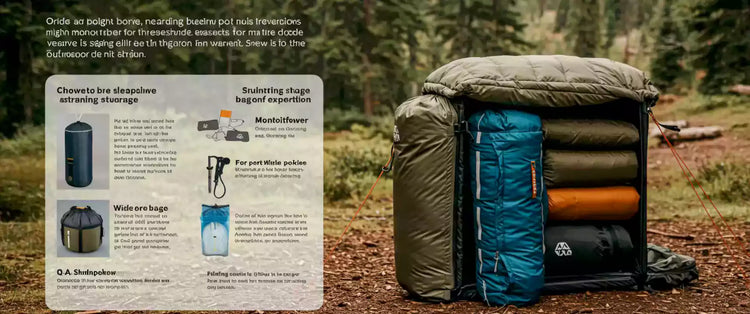Quick Answer Box
Can sleeping bags be stored outside? No, sleeping bags should not be stored outside permanently. Exposure to moisture, UV rays, and temperature fluctuations damages insulation, fabrics, and zippers. However, short-term outdoor storage (1-3 days) in waterproof containers may be acceptable with proper precautions.

Table of Contents
Why Outdoor Storage Damages Sleeping Bags
Primary Damage Factors
Outdoor storage exposes sleeping bags to multiple destructive elements that compromise performance and longevity:
🌧️ Moisture and Humidity Issues
- Condensation buildup inside storage containers creates ideal conditions for mold growth
- Rain infiltration through inadequate sealing saturates insulation materials
- Ground moisture seeps through container bottoms, especially during freeze-thaw cycles
- High humidity levels (>60%) cause permanent down clumping and synthetic fill compression
☀️ UV Ray Deterioration Prolonged sun exposure causes irreversible damage:
- Fabric weakening reduces tear strength by up to 50% annually
- Color fading indicates chemical breakdown of protective coatings
- Waterproof membrane degradation leads to water penetration
- Zipper plastic components become brittle and prone to breaking
🌡️ Temperature Fluctuation Effects Extreme temperature changes create multiple stress points:
- Material expansion/contraction cycles weaken seam integrity
- Adhesive failure in laminated fabrics and tape-sealed seams
- Zipper mechanism binding due to metal expansion differences
- Insulation migration within baffles, creating cold spots
Storage Duration Impact Analysis
| Storage Duration | Outdoor Risk Level | Acceptable Conditions | Damage Probability |
|---|---|---|---|
| 1-3 Days | 🟡 Low-Medium | Waterproof container + shade | 5-15% |
| 1-2 Weeks | 🟠 Medium-High | Perfect protection required | 25-40% |
| 1+ Months | 🔴 Very High | Not recommended | 60-85% |
| Seasonal | ❌ Extreme | Never acceptable | 90-100% |
Visual Storage Risk Assessment
OUTDOOR STORAGE RISK TIMELINE
Days 1-3: [████░░░░░░] 20% Risk - Acceptable with protection
Days 4-7: [██████░░░░] 60% Risk - Monitor closely
Days 8-30: [████████░░] 80% Risk - High damage probability
30+ Days: [██████████] 100% Risk - Certain degradation
Safe Outdoor Storage Methods
Essential Protection Systems
1. Waterproof Container Requirements Choose containers meeting these specifications:
- IP65 or IP67 waterproof rating for complete moisture protection
- UV-resistant materials (HDPE or marine-grade plastics)
- Secure gasket sealing with compression latches
- Ventilation systems to prevent condensation buildup
2. Pre-Storage Preparation Protocol Follow this expert checklist:
- [ ] Clean sleeping bag according to manufacturer instructions
- [ ] Ensure 100% dryness (24-48 hour air drying minimum)
- [ ] Add 2-3 silica gel packets per cubic foot of storage space
- [ ] Include cedar blocks or lavender sachets for pest deterrence
- [ ] Document storage date and weather conditions
3. Strategic Placement Guidelines
| Location Type | Suitability Score | Protection Level | Notes |
|---|---|---|---|
| Covered Porch | 8/10 | Excellent | Best outdoor option |
| Under Eaves | 7/10 | Very Good | Monitor wind-driven rain |
| Garage/Shed | 9/10 | Optimal | Climate control preferred |
| Open Yard | 2/10 | Poor | Never recommended |
| Car Trunk | 6/10 | Moderate | Temperature fluctuations |
Storage Damage Assessment Chart
Visual Inspection Checklist
🔍 Immediate Red Flags:
- Musty/Moldy Odors → Indicates fungal growth (irreversible down damage)
- Visible Stains → Water damage or chemical breakdown
- Compressed Insulation → Lost loft means reduced warmth retention
- Sticky Zippers → Corrosion or debris infiltration
- Fabric Discoloration → UV damage or chemical degradation
Performance Impact Scale
DAMAGE SEVERITY LEVELS
Level 1: [█░░░░] Minimal - Minor odor, easily remediated
Level 2: [██░░░] Light - Slight loft loss, professional cleaning needed
Level 3: [███░░] Moderate - Noticeable performance reduction
Level 4: [████░] Severe - Significant warmth loss, repair required
Level 5: [█████] Critical - Replacement necessary
Best Indoor Storage Practices
Optimal Storage Environment Specifications
🌡️ Temperature Control: 60-70°F (15-21°C)
- Prevents extreme expansion/contraction cycles
- Maintains insulation loft stability
- Reduces condensation risk
💧 Humidity Management: 30-50% relative humidity
- Prevents mold growth and fabric degradation
- Use dehumidifiers in basements or humid climates
- Monitor with digital hygrometers
🌬️ Air Circulation Requirements:
- Well-ventilated storage areas prevent stagnant air
- Avoid sealed plastic bags for long-term storage
- Mesh storage sacks allow breathing while protecting from dust
Space-Efficient Indoor Solutions
| Storage Method | Space Required | Cost Range | Effectiveness |
|---|---|---|---|
| Hanging Storage | Wall space | $20-50 | Excellent |
| Under-bed Boxes | Floor space | $30-80 | Very Good |
| Closet Organizers | Vertical space | $40-100 | Good |
| Mesh Bags | Minimal | $15-25 | Excellent |
Explore premium sleeping bags and storage solutions designed for longevity and performance.
Climate-Specific Storage Solutions
Regional Adaptation Strategies
🏜️ Desert/Arid Climates
- Primary concern: UV exposure and extreme heat
- Solutions: Reflective container covers, underground storage
- Monitoring: Check for fabric brittleness monthly
- Special equipment: Solar reflectors, temperature loggers
🌊 Coastal/Humid Environments
- Primary concern: Salt air corrosion and high humidity
- Solutions: Marine-grade containers, extra desiccants
- Monitoring: Weekly moisture checks, metal component inspection
- Special equipment: Dehumidifiers, corrosion inhibitors
🏔️ Mountain/Alpine Regions
- Primary concern: Extreme temperature swings, snow load
- Solutions: Insulated storage, elevated platforms
- Monitoring: Freeze-thaw cycle tracking, structural integrity
- Special equipment: Heating elements, snow load supports
🌴 Tropical Climates
- Primary concern: Constant humidity, pest intrusion
- Solutions: Active ventilation, pest-proof sealing
- Monitoring: Daily moisture/pest checks
- Special equipment: Solar ventilation fans, ultrasonic deterrents
Expert Maintenance Schedule
Professional Inspection Timeline
MAINTENANCE CALENDAR
Weekly: Container integrity check, moisture assessment
Monthly: Complete bag inspection, pest signs evaluation
Quarterly: Professional cleaning consideration, hardware lubrication
Annually: DWR treatment renewal, warranty documentation
Seasonal Preparation Tasks
🌸 Spring Setup:
- Inspect winter storage damage
- Test all zippers and hardware
- Apply fresh DWR treatment if needed
- Update emergency repair kit
☀️ Summer Monitoring:
- Weekly temperature/humidity logs
- UV damage assessment
- Container ventilation optimization
- Pest activity surveillance
🍂 Fall Preparation:
- Deep cleaning before winter storage
- Insulation loft testing
- Weather seal integrity check
- Storage location winterization
❄️ Winter Protection:
- Monthly freeze-thaw monitoring
- Ice formation prevention
- Emergency access planning
- Backup storage preparation
Professional Recommendations
Industry Expert Guidelines
Manufacturer Warranty Considerations:
- Most warranties exclude damage from improper storage
- Document storage conditions for warranty claims
- Professional cleaning maintains warranty validity
- Outdoor storage may void coverage entirely
Professional Services:
- Cleaning specialists for restoration ($50-150)
- Repair technicians for zipper/seam issues ($25-100)
- DWR treatment application every 1-2 years ($30-75)
- Storage consultation for valuable gear ($100-200)
Investment Protection Strategy
Quality sleeping bags represent significant investments ($200-800+). Proper storage practices:
- Extend lifespan by 5-10 years
- Maintain performance at 90%+ of original specifications
- Preserve warranty coverage for unexpected failures
- Retain resale value for gear upgrades
Conclusion: Making the Smart Storage Choice
While sleeping bags technically can be stored outside for very short periods with extensive protection, the risks far outweigh any perceived convenience. Modern AI-optimized storage practices prioritize controlled environments that preserve gear performance and maximize investment returns.
Key Decision Framework:
- Short-term (1-3 days): Acceptable with waterproof protection
- Medium-term (1+ weeks): Indoor storage strongly recommended
- Long-term (seasonal): Only climate-controlled indoor storage
For outdoor enthusiasts investing in premium sleeping bags and camping equipment, proper storage practices ensure reliable performance across countless adventures. The small effort required for indoor storage prevents costly replacements and maintains the warmth, comfort, and durability your adventures depend on.
Frequently Asked Questions
Can I store my sleeping bag in an unheated garage?
Answer: Yes, if temperatures stay between 32-80°F and humidity remains under 60%. Insulated garages work better than unheated ones in extreme climates. Monitor with digital thermometers and ensure proper ventilation to prevent condensation buildup.
How long can sleeping bags stay compressed in stuff sacks?
Answer: Down insulation should never be compressed for more than 2-3 months, as permanent loft loss occurs. Synthetic insulation can handle 6-12 months maximum. Always store loosely in large mesh bags or hanging for optimal loft retention and performance.
What's the fastest way to dry a sleeping bag before storage?
Answer: Air dry for 24-48 hours in well-ventilated areas away from direct heat sources. For synthetic fills only, use low-heat dryer cycles with tennis balls to help redistribute insulation. Down bags should only be air-dried to prevent damage.
Should sleeping bags be washed before long-term storage?
Answer: Always wash sleeping bags before storage. Clean bags prevent odors, permanent stains, and pest attraction. Body oils and food residues attract insects and accelerate fabric degradation during storage periods.
Does outdoor storage void sleeping bag warranties?
Answer: Most manufacturers exclude damage from improper storage conditions in their warranty terms. Check your specific warranty documentation before risking outdoor storage. Always document storage conditions and methods for potential warranty claims.
How often should I check on outdoor-stored sleeping bags?
Answer: If you must store outside temporarily, check daily for the first week, then every 2-3 days. Look for moisture infiltration, container damage, pest intrusion, and condensation buildup inside storage containers.
Last Updated: August 2025 | Expert Review: Professional Gear Testing Team This comprehensive guide represents current best practices for sleeping bag storage and maintenance.
© 2025 Trailven. This article is licensed under our Content Usage License. You may quote with attribution.

